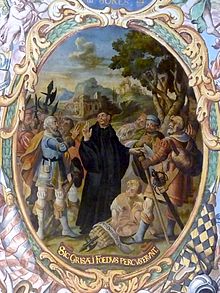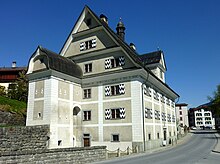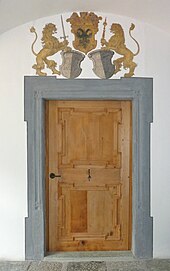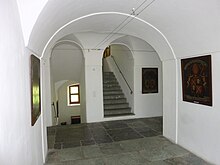Cuort Ligia Grischa
The Cuort Ligia Grischa ( Rhaeto-Romanic in the idiom Sursilvan for "Court of the Gray League"; German name: "Disentiser Hof") is located in Trun in the Surselva in the Swiss canton of Graubünden . It was the seat of the Federal Assembly of the Gray League and the home of the Abbot of Disentis . Today the "Museum Sursilvan" is housed in the Cuort Ligia Grischa.
House
Excavations from 1989 showed that today's stately baroque building on the western edge of the village was built over at least two previous buildings. The found remains of the foundations suggest a simple building. It is conceivable that it dates from around 765, when the Disentis Monastery came to property in Trun through a donation from Bishop Tello . The building first served as the administrative headquarters for the monastery property, then Abbot Peter von Pontaningen made it available to the Gray League as a conference and court venue in 1424.
Under Abbot Nicolaus Tyron von Trun (1580–1593), a larger and more representative building was built in 1588 over the previous building. For example, the door frame on the first floor still dates from this time.
Prince Abbot Adalbert II. De Medell (1655–96) initiated the construction of the current building, which is considered to be one of the most beautiful secular buildings from the Baroque period in the region. It should serve as a worthy framework for the official business of the Gray League and serve as the summer residence of the Disentis abbots. The house was built between 1674 and 1679 under the direction of the builder Pedrut de Rungs from Val Lumnezia . The woodwork was created by master Gion Giger from Trun.
The symmetrically laid out building and the cross-shaped corridor system on all three floors suggest that the house was built from scratch. Under the successor of the builder, Adalbert III. Defuns (1696–1719) the interior of the house was appropriately supplemented. The abbot's living quarters were expanded, the abbot's room paneled, the judges' hall painted and the chapel on the third floor furnished.
As a result, the monastery courtyard remained structurally unchanged, but its importance declined considerably as a result of political changes (French troops marched into Surselva in 1789, the incorporation of the Gray Confederation into the canton of Graubünden, established in 1803, and the relocation of the cantonal government to Chur).
After the fourth fire in the monastery in 1846, financial difficulties caused the abbot to sell the monastery courtyard in addition to goods in Trun in 1859. The buyer was Gion Giachen Cavegn from Dardin , who had become prosperous in Spain. From then on, the house served as a residential building for three families, with the district judge's room always being reserved for the Vorderrhein district court. To cover the cost of maintaining the building, parts of the interior were sold. While the old soapstone stove was sold to the Bodmer-Abegg family in Flims , in 1930 the director of the Rhaetian Railway Gustav Bener (1873–1946) prevented the abbot's panel from being sold by buying it back.
As a result of the discussions about the sale of the equipment, the monastery courtyard came back into the public consciousness. An initiative committee under the government councilors Robert Ganzoni and Giusep Huonder as well as politicians from the federal government and canton enabled the purchase of the monastery courtyard in 1934. The house was renovated on the outside under the direction of the architects Nikolaus Hartmann and Josef Decurtins from Chur, and on the inside by Christian Schmidt from Zurich.
museum
After the renovation, the cloister courtyard was taken over by the “Cuort Ligia Grischa” foundation with the aim of building a cultural center for the region. With the help of loans from the holdings of the Disentis Monastery, the first basic stock was created.
Living rooms on the first floor
On the first floor there are among other things the bedroom and living room of Pater Placidus a Spescha , which he lived in at the beginning of the 19th century. The room is paneled with spruce wood. The coffered ceiling is enclosed by a protruding cornice with embedded drawers. In the middle is the painted coat of arms of Abbot Adalbert III. let in. Brother Peter Solèr from Disentis is considered to be the author of the work. The soapstone stove is in the middle between the living room and bedroom and heated both rooms. The four-poster bed and chest are from 1691, the paneling was added in 1706.
Living rooms on the second floor

The most important historical rooms of the monastery courtyard are located here: the judges' hall and the abbot's rooms. In the eight by five meter hall of the district judge, the delegates of the Gray League met on Jörgentag (April 23), chaired by the district judge, for the annual meeting at which elections were held and justice was given. In 1700 Abbot Adalbert III. commissioned the monk and painter Fridolin Eggert from Disentis to design the eight by five meter room. Eggert left numerous works in the Vorderrheintal, including the painting of the pilgrimage church Maria Licht above the cloister courtyard.
On the ceiling painting the foundation of the Gray League is shown under the maple of Trun as well as the coats of arms of the three leagues and the coats of arms of the abbots Adalbert II. And Adalbert III. On the flags of the numerous putti, the coats of arms and names of the localities involved in the federal government are depicted. The coats of arms on the walls name the 72 names of the federal state judges; however, the list is not entirely complete in the early days.
The cube-shaped soapstone stove with the coat of arms of Abbot Bernhard Frank von Frankenberg is a copy of the original that was sold to Flims around 1920 .
The abbot's rooms include the abbot's sheep and living quarters when it is used as a summer residence. The rich paneling made of local wood also comes from Peter Solèr, which he modestly signed on the back of a drawer: In 1682 I theflet this room, brother Peter Soler . On the ceiling, the complicated coffering is arranged in a star shape around the coat of arms of Abbot Adalbert II. The original soapstone stove bears the name of Abbot Columban Sozzi. The bedroom has the only open fireplace in the house.
The trunk of the maple from Trun , which collapsed in a storm in 1870, is kept in another room . The first covenant was sworn under the tree in 1424.
Another room is dedicated to the work of the Truns painter Alois Carigiet , who always supported the museum. In 1961 he used the culture prize of the canton of Graubünden to create the “Stiva d'art Sursilvana”, the Oberland art room, in the museum to promote local artists. A considerable number of his works are exhibited here. In addition to this permanent exhibition, there are temporary exhibitions of local and foreign artists in the house. One room is dedicated to the local contemporary painter Matias Spescha (1925–2008).
The politicians Caspar Decurtins , cathedral dean Matthias Schgier and district judge Clau Maissen are also presented.
Trun's maple trunk
Room with works by Alois Carigiet
Rooms on the third floor
The house chapel is located here, a small two-bay room. It was created under Abbot Adalbert III. and is dedicated to St. Apollonia . The ceiling painting with representations of Benedictine saints comes from Johannes Jacobus Rieg from Chur, who worked in the Surselva around 1700. According to a handwritten inscription on the back, the small altar structure was again created by Peter Solèr in 1683 as a window frame.
Attic
The twelve built-in chambers in the attic originally provided accommodation for delegates of the Gray League on Jörgentag. Some rooms have been glazed and show everyday Sursilvian culture.
literature
- Peda art guide No. 364: Trun: Cuort Ligia Grischa; Passau 1996
- Erwin Poeschel : Art Monuments of the Canton of Graubünden , Volume IV, Birkhäuser Verlag, Basel 1943, p. 444
- Ludmila Seifert, Leza Dosch: Art Guide through Graubünden , Scheidegger & Spiess, Zurich 2008, p. 222
Web links
- Cuort Ligia Grischa on the ETHorama platform
- Cuort Ligia Grischa on www.graubuendenkultur.ch .
- Trun Museum
Individual evidence
- ↑ Die südostschweiz About a sculpture exhibition by the American artist Lawrence McLaughlin in the Museum Sursilvan, Trun. Retrieved December 24, 2017 .
- ↑ Invitation to an exhibition Barbara Berther, Sweden, exhibitions 2015 in the Museum Sursilvan, Trun. Retrieved December 24, 2017 .
Coordinates: 46 ° 44 '32.9 " N , 8 ° 59' 1.4" E ; CH1903: 718070 / 177971













